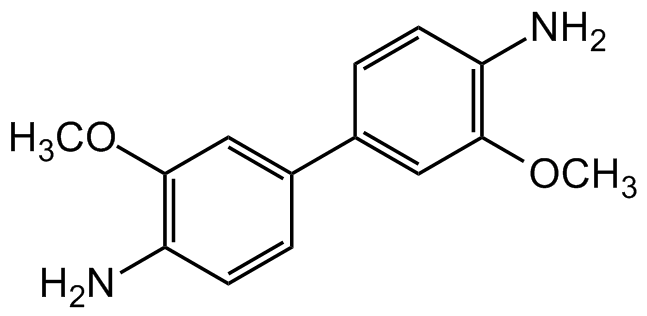o-Dianisidine
| Code | Size | Price |
|---|
| CDX-D1023-G010 | 10 g | £84.00 |
Quantity:
| CDX-D1023-G050 | 50 g | £304.00 |
Quantity:
Prices exclude any Taxes / VAT
Overview
Regulatory Status: RUO
Shipping:
AMBIENT
Storage:
Short Term Storage: +20?C. Long Term Storage: +4?C
Images
Documents
Further Information
Alternate Names/Synonyms:
3,3?-Dimethoxybenzidine; Fast Blue B; Dianisidine; Acetamine diazo black RD; CI Disperse black 6; Cibacete diazo navy blue 2B; Diato blue base B
Appearance:
Light yellow to brown to pink powder.
CAS:
119-90-4
EClass:
32160000
Form (Short):
solid
GHS Symbol:
GHS07,GHS08
Handling Advice:
Protect from light and moisture.
Hazards:
H302-H350
InChi:
InChI=1S/C14H16N2O2/c1-17-13-7-9(3-5-11(13)15)10-4-6-12(16)14(8-10)18-2/h3-8H,15-16H2,1-2H3
InChiKey:
JRBJSXQPQWSCCF-UHFFFAOYSA-N
Long Description:
Chemical. CAS: 119-90-4. Formula: C14H16N2O2. Molecular Weight: 244.29. o-Dianisidine is a peroxidase substrate and used as a redox indicator dye. Redox indicators are colorimetric reagents which provide a characteristic color change at a specific electrode potential. o-Dianisidine has been has been used for neutrophil myeloperoxidase activity (MPO) assay or measurment of glucose-oxidase or caeruloplasmin oxidase. It is used as an intermediate for the preparation of azo dyes, pigments and o-dianisidine diisocyanate, which finds application in adhesives, polyurethane elastomers and resins. It is also used in various industries like leather, paper, plastics, rubber and textiles. It acts as a reagent to detect metals, thiocyanates and nitrites. It is incompatible with strong oxidizing agents.
MDL:
MFCD00008372
Molecular Formula:
C14H16N2O2
Molecular Weight:
244.29
Package Type:
Vial
PG:
III
Precautions:
P201 - P301 + P312 + P330 - P308 + P313
Product Description:
o-Dianisidine is a peroxidase substrate and used as a redox indicator dye. Redox indicators are colorimetric reagents which provide a characteristic color change at a specific electrode potential. o-Dianisidine has been has been used for neutrophil myeloperoxidase activity (MPO) assay or measurment of glucose-oxidase or caeruloplasmin oxidase. It is used as an intermediate for the preparation of azo dyes, pigments and o-dianisidine diisocyanate, which finds application in adhesives, polyurethane elastomers and resins. It is also used in various industries like leather, paper, plastics, rubber and textiles. It acts as a reagent to detect metals, thiocyanates and nitrites. It is incompatible with strong oxidizing agents.
Purity:
>97.0% (GC)
Signal word:
Danger
SMILES:
NC1=C(OC)C=C(C2=CC(OC)=C(N)C=C2)C=C1
Solubility Chemicals:
Soluble in methanol (10 mg/ml) or ethanol (10 mg/ml).
Transportation:
Excepted Quantity
UN Nummer:
3077
UNSPSC Category:
Fluorescent Reagents
UNSPSC Number:
41105331
Use & Stability:
Stable for at least 2 years after receipt when stored at RT.
References
(1) A.S. Hugget & D.A. Nixon; Lancet 273, 368 (1957) | (2) K.H. Schosinsky, et al.; Clin. Chem. 20, 1556 (1974) | (3) A. Hulanicki & S. Glab; Pure Appl. Chem. 50, 463 (1978) | (4) K. Takayama & M. Miura; Jpn. J. Physiol. 31, 269 (1981) | (5) W.F. Beyer & I. Fridovich; Anal. Biochem. 170, 512 (1988) | (6) K. Hunger, et al.; Ullmann's Encycl. Industr. Chem. (2000) | (7) M. Catala Icardo, et al.; Analyst 126, 2087 (2001) | (8) J. Jasnowska, et al.; Bioelectrochemistry 64, 85 (2004) | (9) E. Perju, et al.; Liq. Cryst. 42, 1309 (2015) | (10) S. Sundaram, et al.; RSC Adv. 5, 45996 (2015)



